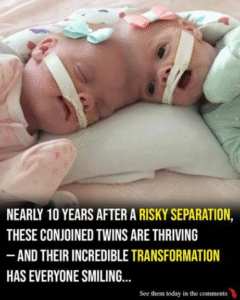Conjoined Twins Abby and Erin Delaney: Inside Their Remarkable Story
When Heather and Riley Delaney learned they were expecting a baby, they imagined the usual possibilities—names, nursery colors, and the soft rhythm of a newborn breathing peacefully in their arms. What they could not imagine, not in their wildest dreams, was the extraordinary journey that awaited them. At just over 11 weeks into the pregnancy, during what should have been a routine scan, the technician grew unusually quiet. Minutes later, the doctor delivered news that felt both surreal and terrifying: the Delaney babies were conjoined, joined at the top of the head—a condition known as craniopagus.
It is one of the rarest forms of conjoinment, affecting only a tiny fraction of identical twins worldwide. But rarity was not the only challenge. The girls shared blood vessels and crucial cranial structures. Even in the best hands, surgical separation is among the most complex procedures in the realm of pediatric medicine.
For the Delaneys, the diagnosis came like a wave crashing over their expectations. Fear, grief, hope, and determination all collided. Yet beneath the uncertainty, one belief anchored them: these babies were theirs, and they were going to fight for them.
A Fragile Beginning
Abby and Erin were born prematurely via C-section at the Children’s Hospital of Philadelphia (CHOP), one of the few institutions in the world with the expertise and experience to attempt a separation of this magnitude. From the moment they arrived, they were placed in the care of a large, multidisciplinary team—neurosurgeons, plastic surgeons, anesthesiologists, nurses, developmental specialists—each playing a role in orchestrating hope.
The first days were delicate. The twins shared not only physical structures but a tight bond of presence—breathing together, sleeping together, living their entire world within inches of each other. Their mother often recalled that even though they were so medically fragile, they seemed to comfort one another simply by being close.
Because of their shared cranial connection, every decision required precision. How to position them. How to feed them. How to help them grow strong enough for the surgery that everyone knew would eventually come.
Preparing for the Impossible
Over the following months, their care team mapped every shared vein, bone, and brain structure using advanced imaging and 3D modeling. The family met with surgeons who explained each risk with honesty and compassion. One surgeon admitted candidly, “A separation of this type is like navigating through the most delicate terrain imaginable. One wrong turn could be catastrophic.”
But as the twins slowly grew, so did the possibilities. Their medical team began planning a groundbreaking operation—one that would unfold in carefully choreographed stages. Custom devices were made to expand their skin so each girl would have enough coverage for her own head after separation. Specialists rehearsed their roles repeatedly, down to the smallest movement.
Heather later said that preparation felt like “holding your breath for months,” knowing that the moment of truth was coming, and everything—everything—would depend on what happened in a single operating room.
The Day of Separation
When the day finally arrived, the hospital buzzed with a quiet, reverent intensity. More than two dozen medical professionals filled the operating theater. Monitors beeped steadily. Sterile lights gleamed. And in the center of it all lay Abby and Erin—tiny, resilient, and surrounded by a kind of human devotion that transcended job titles.
The surgery spanned many hours. Surgeons delicately separated shared veins, carefully divided bone, and reconstructed the girls’ individual skulls. Throughout the process, teams rotated in shifts, maintaining the highest level of focus and endurance.
And then, at long last, came the moment. The girls—who had lived every second of their lives connected—were gently placed onto separate operating tables.
For the first time, Abby and Erin existed as individuals in physical space.
The room fell almost silent as the significance sank in. Exhausted surgeons allowed themselves a breath. Nurses exchanged emotional glances. It was, in every sense, a medical miracle—and a testament to human determination.
The Road to Recovery
But separation was not the end of the story; it was the beginning of a new chapter. Recovery was slow, layered, and emotionally intense. The girls faced additional procedures, therapy, and careful monitoring. They had to learn how to move their heads independently, how to balance, how to interpret the world as individuals after experiencing it for so long as one.
Heather spent countless hours at their bedsides, singing to them, holding their hands, celebrating every small victory—a finger curl, a head turn, a soft coo of recognition. Erin tended to be more cautious, studying her new surroundings with thoughtful eyes. Abby, by contrast, seemed adventurous, ready to push forward with fierce determination. Their personalities, once intertwined, began unfolding distinctly.
Doctors marveled at their progress. Each milestone symbolized both the triumph of modern medicine and the unwavering strength of this family.
A Story That Inspires the World
As the Delaney twins grew, their story began to inspire people far beyond the hospital walls. News outlets shared updates. Families facing medical uncertainty found hope in their journey. The twins became symbols of resilience—not because their path was easy, but because they traveled it with courage, a devoted family, and a village of experts lifting them along the way.
Their parents often reflected on the journey not through the lens of fear, but through gratitude. Gratitude for the surgeons who dared to attempt the impossible. Gratitude for the nurses who cared for the girls as though they were their own. Gratitude for the tiny moments—the first smile, the first laugh, the quiet evenings where the twins rested peacefully in separate beds, living the life that had once felt unreachable.
Living Their Own Lives
Today, Abby and Erin continue to grow, learn, and explore the world as two unique individuals connected not by anatomy but by an unbreakable bond. They face challenges, yes, but also victories—milestones that once seemed distant, now celebrated with pride and joy.
Their story endures as a testament to medical innovation, love, teamwork, and the extraordinary capacities of the human spirit. It reminds us that even in situations that feel impossible, there can be light, progress, and breathtaking transformation.
The Delaney twins began life sharing one head—and now share a future filled with possibility.


